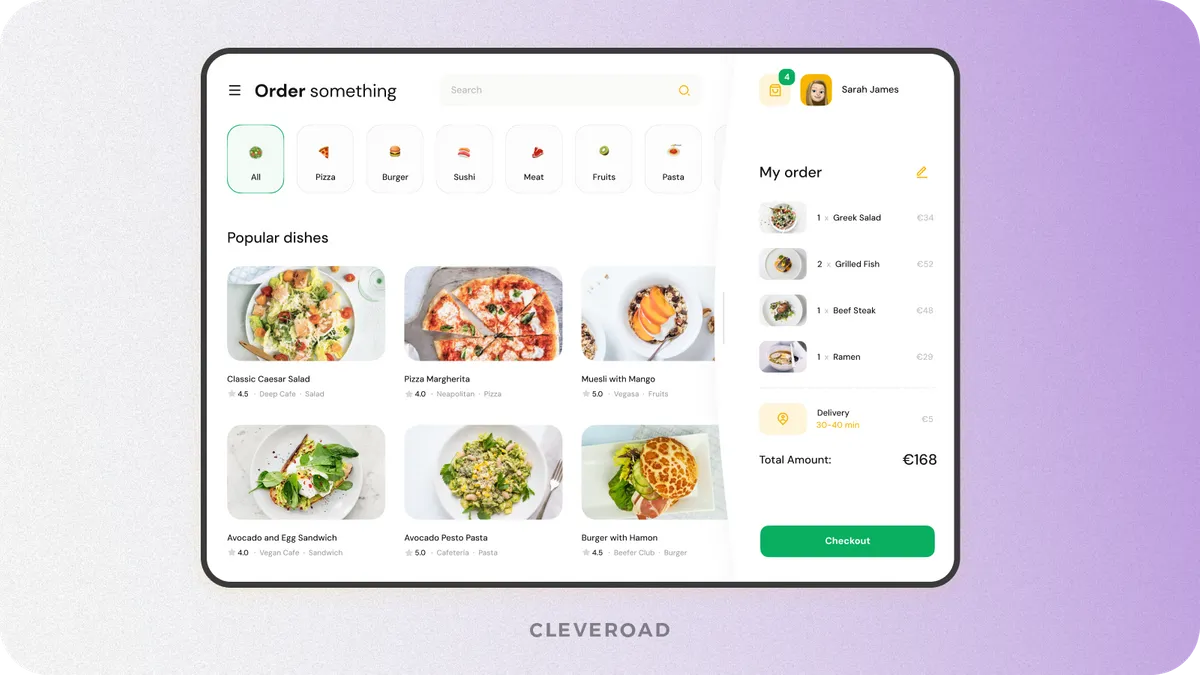How to Make a Food Ordering Website: Features, Cost, Steps to Follow
Updated 07 Jan 2026
20 Min
11874 Views
How to create a food delivery website and succeed? Fast, affordable delivery has become a must-have rather than a nice-to-have thing. Beyond convenience, this niche offers business owners a chance to build a scalable revenue stream and build strong customer loyalty for long-term ROI.
As an IT partner with over 15 years of experience in digital solution delivery, in this guide we’ll walk you through what makes a food delivery website successful, from must-have features and development stages to budget insights and expert tips for a smooth launch.
Why to Make a Food Ordering Website?
According to Statista, the global online food delivery market is expected to reach $1.38 billion in 2025. More and more people are shifting towards online ordering system usage to not distract from critical activities and save precious time.
Let's see what the potential of this idea is:
- Over 25% of American consumers use delivery services at least once a week
- Utilizing delivery services increases restaurants sales volume for 10%-20%
- It is predicted that the overall user count of meal delivery services will reach $2.2 billion in 2025
- About 63% of customers prefer getting delivery to dining out
The increased utilization of mobile devices, demand for fast service, and virtual payment solutions drive the growth of the food delivery market. Above all, the convenience of ordering food through ordering websites for restaurants significantly contributes to their popularity. These platforms allow customers to easily compare the menu and prices of various restaurants, place an order delivery request, and use a credit card to pay. Given these trends, it's profitable to create a food delivery website that meets global market needs and consumer demand.
Food delivery website monetization strategies
The idea to make a website for food delivery may transform into a great opportunity to establish a reliable revenue stream. Below, explore the most common monetization strategies along with how leading platforms successfully apply them.
- Commission fees from restaurants. The platform takes a cut from every order placed through the site. This is the core revenue stream for most food delivery services. Uber Eats charges a commission that ranges from 15% to 30%, depending on the visibility they opt into.
- Delivery & service fees from customers. Customers are charged extra for the convenience of ordering and delivery, helping cover logistics and platform costs. DoorDash, for example, includes a service fee and a delivery fee that vary based on order size, location, and demand.
- Subscription-based models. Platforms offer paid memberships in exchange for perks like unlimited free delivery or exclusive deals. Deliveroo Plus and Uber One provide monthly plans that enhance user loyalty while generating steady recurring income.
Food ordering website development trends
As with any industry, food ordering constantly goes through particular changes that suddenly become wholesome tendencies. Let’s discuss 3 most vibrant trends in food delivery websites:
AI-driven personalization
AI-powered algorithms are an effective method to offer tailored recommendations based on user behavior, preferences, and past orders. This usually includes suggesting particular dishes, dineries, or even specific dietary options to individual users. Moreover, utilizing AI development services enable businesses to meet consumer expectations when it comes to customizations and highly personalized experiences within food delivery websites.
Integration of voice search and chatbots
To make a food ordering website truly innovative and appealing for users, consider implementing voice search functionality and AI chatbots. These features are integrated into food ordering websites to simplify and speed up the ordering process. Users can place orders, ask for recommendations, or check delivery statuses using voice commands or by interacting with a chatbot.
Sustainability and ethical eating
Websites have started to incorporate features that promote sustainable and ethically sourced food options. This may include filters for organic, locally sourced, or zero-waste meals. Some platforms enable users to see the carbon footprint of their orders or choose eco-friendly option.
As a lot of consumers become more environmentally aware, platforms try to align with their clients' values. By adding such functionality, you can attract and retain a user base that prioritizes an eco-friendly lifestyle, setting your offer apart from competitors who don’t cater to this growing demand.
Ready-Made vs. Custom Food Ordering Website Development
When planning to build an online food ordering website, you’ll reach a major crossroads: develop it from scratch or use a ready-made platform. Let’s break down both options to help you choose the one that best aligns with your business goals.
Ready-made food delivery website
A ready-made food delivery website is a pre-built platform that you can quickly set up and start using. These solutions are generally more affordable and faster to deploy.
Here are the main benefits of off-the-shelf food ordering website creation:
- Quick deployment. Ready-made food delivery sites are easy to implement, and it takes a few hours or a couple of days to have these solutions in place.
- Lower initial cost. These solutions are normally cheaper when it comes to purchasing. Therefore, they can be tailored for small businesses or even fresh start-ups.
- Simplified software management. It is normally easy to use and does not require specific IT expertise to run and manage most of ready-made food website solutions.
- Accessible updates. The provider usually performs updates, keeping your platform up-to-date.
Let’s also disclose the cons of ready-made food ordering websites:
- Limited customization. Your ability to define the level of customization of features, design, and integrations is usually restricted.
- Scalability Issues. Ready-made solutions may not scale well as your business grows, as you’re always tied to the service provider.
- Generic design. The design of your food delivery website won’t stand out since many other businesses might also use the same website template or platform.
- Recurring costs. You might need to pay ongoing subscription fees, which can add up over time.
Custom food delivery website
A custom-built food delivery website is designed and developed exclusively to meet your unique business needs and requirements specifically. It offers flexibility and allows you to create a platform that perfectly aligns with your brand and operational requirements. Here are the main benefits restaurants, business owners, and delivery services can extract from custom-built food delivery websites:
- Well-tailored features. When you make a food ordering website from scratch, you can add the functions that correspond to the nature of your business, like separate forms of payment, individual systems of bonuses, or special systems of order tracking.
- Wholesome brand identity. You can make a food ordering website that organically aligns with your brand identity, especially on custom UI/UX that will conform to the targeted audience.
- Scalability according to your needs. Your food delivery site is developed from scratch with a huge potential for future expansions.
- Diverse integration options. Additionally, you can connect third-party tools like CRM, ERP, or custom analysis tools to match your requirements.
- Enhanced security. The benefits that come with having customized food ordering websites are all-round security since the code used is unique and won’t have major loopholes.
Anyway, custom development has potential disadvantages, including higher cost, longer development time and possible challenges in future updates. However, custom food delivery website development may be better for disclosing your concept's true potential, as you can tailor every detail to match your business image. Besides, in the long run, a custom food ordering solution is a considerable finance saver, as you won’t have to worry about increasing fees from off-the-shelf website builder providers.
Cleveroad expert tip: For sure, you’re the main decision-maker when it comes to the form factor of your food-ordering website. However, a custom-built food delivery website is generally the better choice for businesses that want full control over their platform. This includes the need for a unique set of features, scalability potential, and general alignment of your business values and food delivery website. Undoubtedly, initial investments are much higher. At the same time, the long-term benefits of having a food ordering site that perfectly fits your needs offers robust security, and allows for seamless scalability often outweigh the downsides.
Essential Features For Food Ordering Website Development
To minimize multiple risks associated with inefficient investments or unfulfilled expectations during your food delivery website launch, it’s highly recommended to start with a Minimal Viable Product (MVP) development. This means creating a simplified version of a food ordering website with basic functionality only to test it under real-world conditions.
Below, we’ve described 4 main functionality modules along with one extra module regarding third-party integrations essential for your meal delivery platform functioning.
User module
User-side functionality helps your user seamlessly navigate the food delivery website. Here are key features it’s vital to include:
User registration & login
This feature lets users sign up or log in using email, phone number, or social accounts like Google or Facebook. It ensures secure access and a personalized experience, saving addresses, past orders, and payment methods for faster checkouts. Quick onboarding helps users dive into ordering without friction. It's one of the first things to consider when planning how to create food delivery website.
Search & filter
Helps users quickly find the food they’re craving. They can search by restaurant name, cuisine type, dish name, or dietary preference. Filters like “fast delivery,” “top-rated,” or “budget-friendly” give them more control, making the experience smoother and more satisfying.
Order placement
Once users pick their meals, this feature walks them through customizing items, selecting delivery options, and confirming orders. It’s all about making checkout feel effortless. A clean UI and clear instructions help avoid confusion and speed up the process — essential when you want to create food ordering website users will keep coming back to.
Delivery module
No food ordering app can go without delivery men. Your main goal here is to make their service intuitive, convenient, and as hassle-free as possible. Here’s what functionality this module will require:
Driver registration and profile
Delivery partners can sign up, upload necessary documents, and create a profile that includes their contact info and delivery areas. This ensures that only verified drivers work on the platform, boosting reliability and trust for users.
Order assignment and routing
Drivers receive order notifications with pickup and drop-off info. Integrated routing systems help them find the fastest path using GPS. This feature reduces delivery time and keeps food hot and fresh, which is a big deal in customer satisfaction.
Status updates and proof of delivery
Drivers can mark their progress like “order picked up” or “delivered.” Some systems include a digital signature or photo confirmation to confirm drop-off. This feature keeps everything transparent and reassures customers that their order is on its way. When you create online food ordering website logic, features like this are must-haves to build trust.
Apart from the website, you can consider creating a food delivery app to expand your reach. Check out our guide to learn about it in more detail
Restaurant module
Throughout this module, the restaurants can become a part of your food website and manage their service and presence within it. These are features to facilitate a convenient collaboration:
Restaurant registration and profile management
Restaurants can join the platform by registering and filling out their profile with business hours, contact details, addresses, and images. This feature helps them stay visible to customers while building trust through transparent and up-to-date info.
Menu management
Gives restaurant owners full control over what they offer. They can add, update, or remove items, upload pictures, and set pricing. It also supports tagging items as “popular,” “new,” or “out of stock,” making it easier for customers to explore what’s hot or unavailable.
Order management
This feature notifies the restaurant when a new order comes in and shows order details, customer preferences, and delivery instructions. Restaurants can update the order status in real-time – like “preparing” or “ready for pickup” – to keep customers informed. It’s a critical part when thinking about how to make online food delivery website infrastructure effective and scalable.
Admin module
The admin module is the command center of your food ordering platform, giving restaurants and administrators the tools to keep things running smoothly. It’s where restaurants can register, showcase their offerings, and manage day-to-day operations, from menus to order flow. Here’s the essential functionality this module should include:
Dashboard & analytics
The admin dashboard gives a real-time view of what’s happening on the platform — user activity, sales, order volumes, top-performing restaurants, and more. It helps business owners make smarter decisions by showing what’s working and what needs tweaking.
User & vendor management
Admins can add, edit, or deactivate users and restaurant accounts if needed. This feature ensures the platform stays secure and high-quality by allowing control over who participates in the ecosystem.
Commission & payment management
Automates fee deductions from orders, handle payouts to restaurants and drivers, and keeps payment records organized. It saves time and reduces the risk of human error in financial operations, making sure everyone gets paid on time. Smart financial handling is a pillar of how to build a food ordering website that actually makes money.
Third-party integrations
To enhance the functionality and user experience of your food delivery website MVP, you’ll need to integrate particular third-party services. This will help you support seamless connections with key services such as payment processing, delivery management, customer support, and analytics. By integrating third-party solutions, you will improve customer engagement, and optimize delivery processes, all while providing secure transactions and real-time updates.
Below, you can examine key third parties required for your food ordering site to run smoothly:
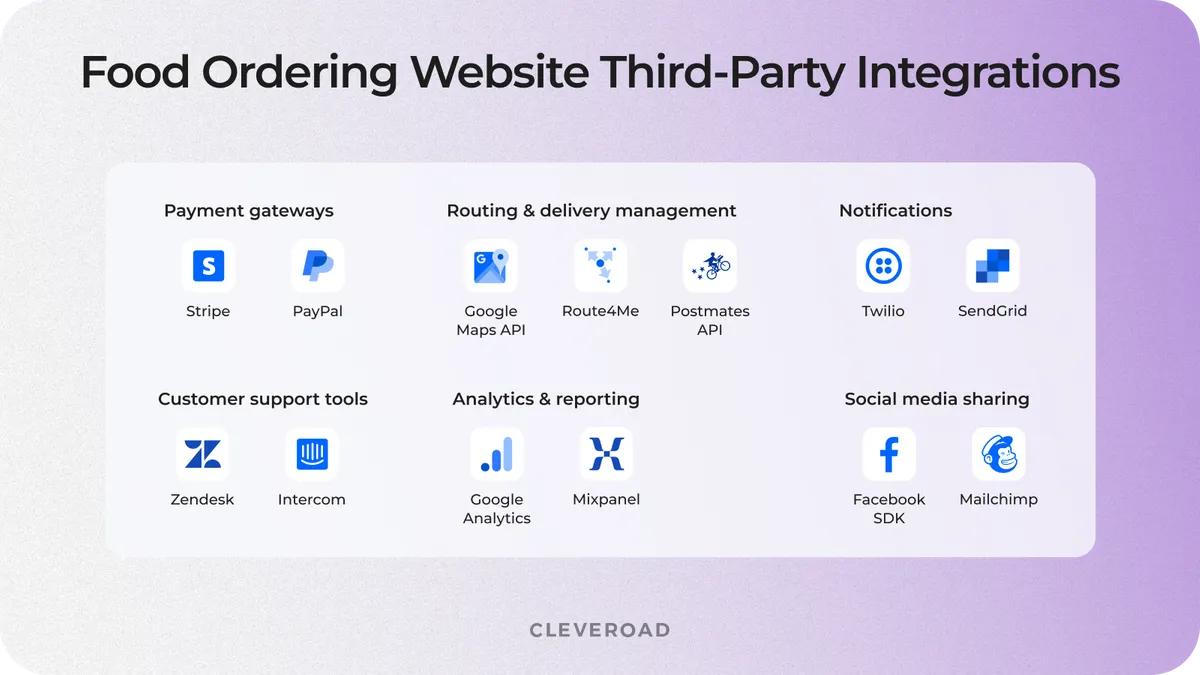
Food website third-party integrations
Steps to Build a Food Ordering Website
Below, you can examine a comprehensive 7-step roadmap we’ve compiled to help you better understand the overall food ordering website development flow.
Step 1. Define your target audience and business goals
Start by understanding who you're building your platform for – busy professionals, students, families, or a mixed audience. Pinpoint their needs and define your value proposition accordingly. Besides, it’s crucial to set clear, measurable goals. Do you want to dominate a local niche or scale nationwide? These insights will influence every decision ahead. At this early stage, focus on how to create a food ordering website that resonates with both customers and restaurant partners.
Step 2. Go through partner acquisition
Before the tech build begins, start forming partnerships with restaurants, cafes, or ghost kitchens in your target area. Approach them with a solid business idea and value proposition – like increased order volume and exposure. You don’t need a finished platform to start forming these relationships. Instead, build trust through clear terms, future promotional plans, and platform benefits. Early partnership development ensures your site has variety and credibility when it goes live, boosting your chances of traction from day one.
Step 3. Select a reliable IT vendor
Choosing the right IT partner sets the tone for the entire journey. Look for a team with proven experience in food tech, an extensive portfolio, and a good amount of feedback from their past clients. They should understand your business goals, tech requirements, and timeline. Whether you want to create a food delivery website from the ground up or just need tech muscle, an expert vendor bridges ideas and implementation with minimal risk and maximum output.
We've an extensive experience of collaboarting with businesses from various business domain, and also delivering on-demand solutions. One of such cases is MoveUp - transportation app designed to connect riders with nearby drivers, with a special focus on serving individuals with disabilities or specific medical transportation needs.
Here’s what John Salmon, founder at Unified Potential, Inc.dba MoveUP says about collaborating with Cleveroad on creation of on-demand ridesharing solution:


Step 4. Define the features set of your food website
Your IT vendor will collaborate with you to shape a well-prioritized feature list. This includes must-haves like user registration, real-time order tracking, multiple payment options, and restaurant dashboards. Together, you’ll align features with your business goals, ensuring to build an MVP that will help you test the basic version of your site with minimum features under real-world conditions. Further, along with your team, you’ll be able to scale the food website, adding more advanced functionality. With experts, you can avoid overbuilding and focus on what drives customer satisfaction and revenue.
Step 5. Create a vibrant food delivery site UI/UX
With help from your vendor’s design team, you’ll craft a user interface that’s intuitive, attractive, and conversion-friendly. Experts will apply UX best practices to ensure customers can browse menus, place orders, and track deliveries without friction. They’ll also tailor the design to mobile-first behavior, so your site shines across all devices. A thoughtful design process turns casual visitors into repeat customers, all while reflecting your brand’s identity and vision for the food ordering experience.
Step 6. Develop a food-ordering website
Now your team starts to make a food ordering website technical build. Your IT team will handle both front-end and back-end development, ensuring smooth integrations with maps, payment gateways, restaurant CRMs, and delivery tracking APIs. They’ll run regular demos, sync with you on priorities, and ensure the codebase meets your project goals. Agile methodology and quality assurance processes will keep your project on track.
Step 7. Launch and maintain your food ordering site
Your vendor will support the product launch with final testing, server deployment, and app store submissions if needed. Post-launch, they’ll offer ongoing maintenance, tech support, and performance monitoring to ensure everything runs smoothly. This includes bug fixes, scalability enhancements, and updates based on user feedback. Long-term success depends on consistency, and your IT partner will help optimize the platform as your user base grows.
Real-World Examples of Successful Food Ordering Websites
It’s always a good idea to study competitors first. If you want to create a food delivery app or website, it’s better to consider details. We’ve prepared five online food ordering platforms for you to review.
UberEats
UberEats gives you an idea of how to create a food-ordering website and start making money. A lot of people trust Uber to drive them around the city. So, the company decided to conquer new peaks and become successful in the food delivery market. In 2024, UberEats is available in 11,000 cities all over the world. Uber Eats covers approximately 29 percent of the global food delivery market, delivering food from more than 600,000 restaurants. Uber Eats has functionality similar to Uber, such as cashless transactions, real-life GPS tracking, and order scheduling.
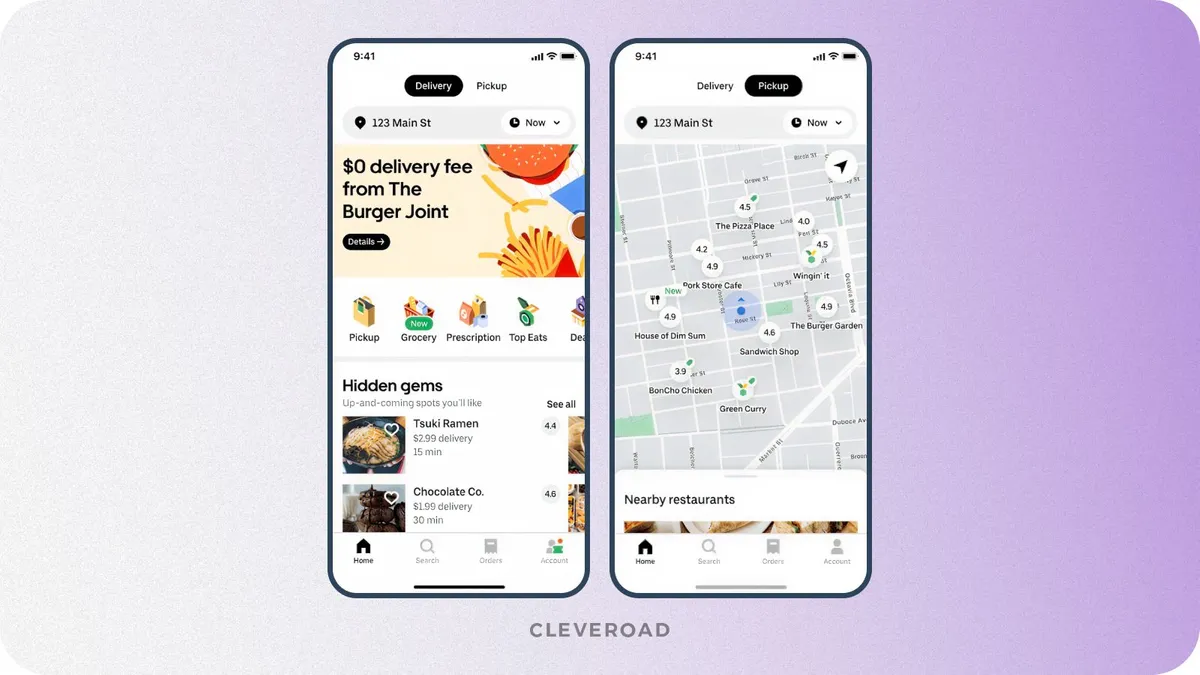
UberEats interface
DoorDash
DoorDash is one of the biggest food delivery services in the United States. This service is available in 4000+ American and Canadian cities. It has more than 340,000 restaurant menus and over 30 different cuisines. DoorDash provides a chance to select ‘popular items.’ For example, visiting a restaurant for the first time, you can see the most demanded food.
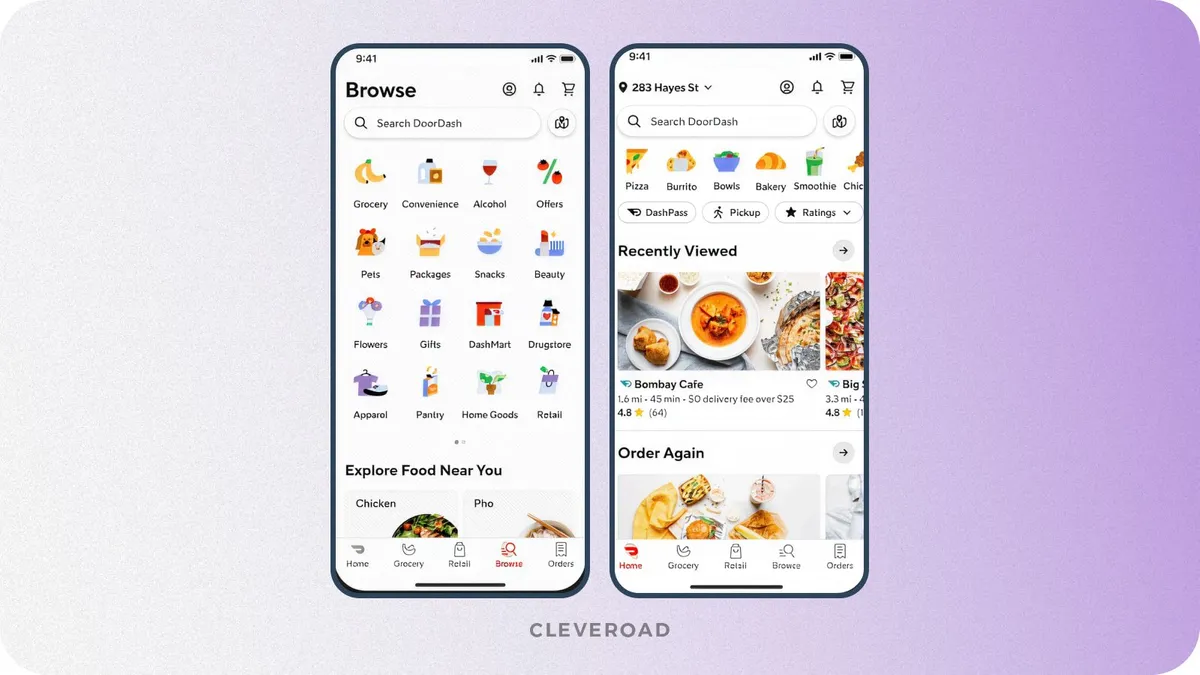
DoorDash interface
GrubHub
Grubhub is another good example of how to create a food delivery website. The platform is available for both iOS and Android. The service operates in the United States, and it lets users order and deliver meals from fast food chains and restaurants across 4000 cities. Grubhub provides 24/7 customer support and real-time delivery tracking, which makes this process very convenient.
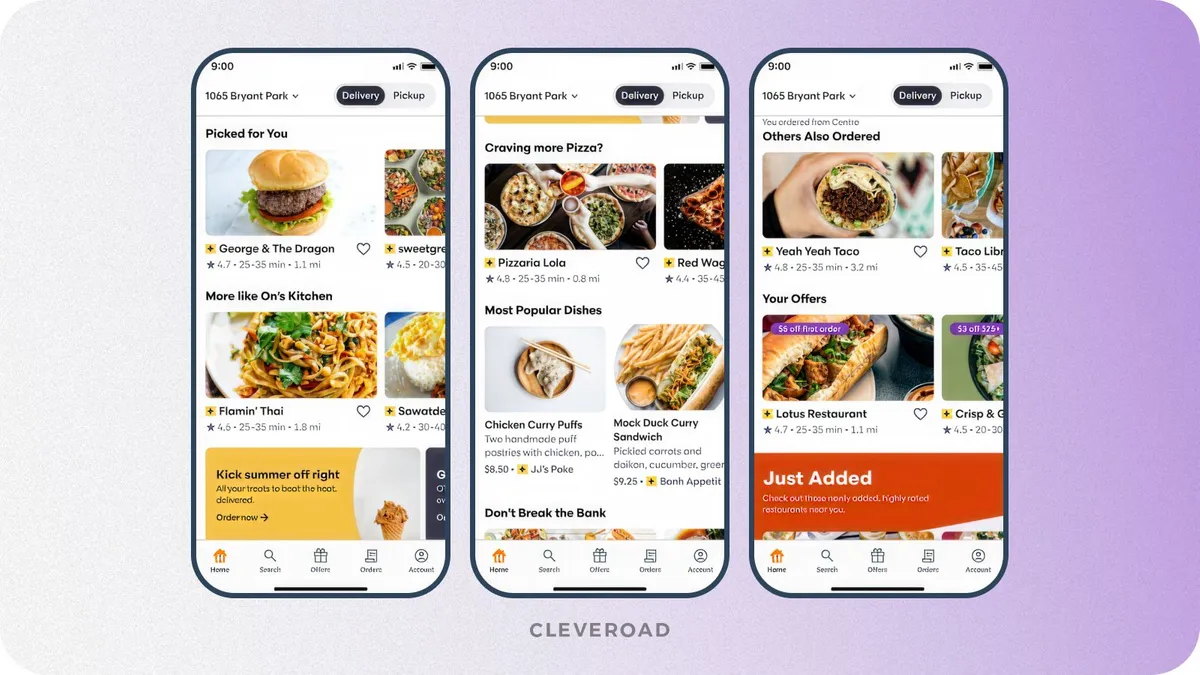
GrubHub interface
Tips for Food Ordering Website Development
We have an extensive experience of delivering on-demand delivery web solutions and perfecty know common pitfalls business owners and entrepreneur may come throught. We’ve prepared several tips to help you create a food delivery website and succeed.
Optimize for order abandonment recovery
To minimize order abandonment, design your checkout process to be as seamless as possible. Implement strategies like offering discounts for abandoned carts, sending reminders via email or SMS, and simplifying the payment process. Additionally, give customers an option to save their order for later, making it easier for them to complete the purchase when they’re ready. By addressing this, you’ll improve conversion rates and reduce lost sales, boosting overall revenue.
Integrate predictive search for dishes
To build food delivery website and make it convenient, consider integrating predictive search that will help you enhance user experience by helping customers find their favorite dishes faster. This feature predicts dish names, categories, or ingredients as users type in the search bar. By displaying suggestions in real time, you guide users towards making quicker decisions, reducing search time and increasing the likelihood of completing an order. Predictive search also personalizes the experience, suggesting items based on previous orders, enhancing customer satisfaction.
Enable hyperlocal customization
Hyperlocal customization is about tailoring your food delivery service based on the specific preferences, needs, and location of your users. This involves offering personalized menu options, including regional dishes, based on customers' geographic areas. Additionally, adjust delivery times and service areas to suit local demand. This level of customization enhances the overall user experience, making your platform feel more relevant and connected to each customer.
At Cleveroad we provide top-tier custom software development services. Check out our service page to learn how we can assist you in custom food ordering website development
Cost to Build a Food Ordering Website
So, let’s find out the final price to create a food delivery website. All the estimates below are based on the average rate in our region (Central Europe, Estonia) — $50 per hour.
| Type of work | Approximate time (h) | Approximate cost ($) |
Customer-facing solution | 249 hours | $12,450 |
Restaurant solution | 164 hours | $8,200 |
Courier solution | 364 hours | $18,200 |
Admin panel | 255 hours | $12,750 |
Frameworks and libraries integration | 64 hours | $3,200 |
UI/UX design | 60 hours | $3,000 |
Quality assurance | 350 hours | $17,500 |
DevOps services | 30 hours | $1,500 |
Project management | 80 hours | $4,000 |
Total | 1,616 hours | $80,800 |
How did we calculate the final price to make a website for food delivery? We added development and non-development time. After that, we multiplied the time by the team’s hourly rate.
So, to build a food delivery website, you need at least $80,800. We calculated the MVP version of the service. If you want to add more advanced features, you’ll likely pay more.
Notice: The time and price above is approximate. Feel free to contact our Senior Business Analysts to get a custom feature list and project estimate.
Additionally, the final price can vary depending on the team’s location. For example, developers from North America have higher rates in comparison to software engineers from Central Europe. To give you a hint, we’ve estimated the approximate cost to make a food ordering website in worldwide:
- Central Europe. $80,800 (based on $50/h)
- North America. $161,600 (based on $100/h)
- Western Europe. $145,440 (based on $90/h)
- Australia. $161,600 (based on $100/h)
Cleveroad – Your Credible Vendor for Food Ordering Website Development
Cleveroad is a custom software development company with over 13 years of experience in the IT market. Our team has been helping startups, SMBs, and enterprises to get custom software solutions for various domains, including on-demand platforms.
By cooperating with us, you'll be ensured of the following benefits:
- Full-cycle software development with a complete software team, going from planning, design to coding, testing, and launch. After release, we provide you with ongoing support and updates to keep the product running smoothly
- 250+ in-house software engineers available, including mobile and web developers, DevOps, designers, PMs, QA engineers, business analysts, and more
- A variety of flexible partnership models suitable for your particular resource needs: Dedicated Development Team, Project-Based Model or IT Staff Augmentation
- Cooperation with an IT partner certified with ISO 9001:2015 (quality management), and ISO/IEC 27001:2013 (security management), guaranteeing outstanding quality and robust security for your solutions
Our portfolio covers a lot of custom software development projects in different domains, including on-demand application. One of our latest cases is a P2P ridesharing solution.
MoveUp is a transportation app built for a French startup aiming to connect riders with drivers who can meet accessibility and medical-related needs. Unlike typical ride-hailing apps, it required a more tailored approach—shifting from the Uber-like model, introducing custom filtering, offline driver validation, and flexible payment options including free rides.
The project kicked off with an in-depth business analysis – 20+ planning meetings over two weeks – resulting in a detailed specification, wireframes, clickable prototype, and project estimate.
Key features the Cleveroad team delivered include:
- Real-time tracking & updates: Riders view nearby cars, track accepted rides live, and receive instant notifications.
- Custom ride filtering: Filters adjust to user-defined needs using tailored matching algorithms.
- Flexible payments: Stripe integration allows secure peer-to-peer payments, refunds, cancellation fees, and donations.
- Offline driver validation: Admins manually approve drivers, ensuring trust and quality for sensitive rider groups.
As a result, our client received a scalable, ready-to-use platform tailored for riders with unique transportation needs—balancing usability, accessibility, and operational efficiency.
Here’s what John Salmon, founder at Unified Potential, Inc.dba MoveUP says about collaboration:
John Salmon, founder at Unified Potential, Inc.dba MoveUP provides feedback about collaboration with Cleveroad
Before diving deeper into food delivery website development, you need to conduct market research, select the revenue model along with required features, and choose a reliable software development company to transform your idea into a powerful business solution. Whether you're building a restaurant website, an online shop, or a website with online ordering, every element—from the menu item layout to optimization and seamless website design—matters. For instance, at Cleveroad, the development process consists of four stages: Discovery phase, UI/UX design, Software development by sprints, and Product release with built-in features tailored for your online store.
Every food ordering platform has three different stakeholders. So there are three different solutions it requires: user-facing solution, restaurant solution, and courier solution. If you plan to create an online ordering system for restaurants, each of these components needs to be carefully designed to ensure smooth operations. You’ll also need an admin panel to manage all participants effectively. Whether you're building a restaurant online presence or working on website design for your online food ordering system, your goal is to create a website that supports your food business. A successful restaurant website with online ordering depends on a well-thought-out feature set for every part of the platform.
The average cost to create online food ordering website is $80,800+. However, the final price will depend on two main factors: time and developers’ rates. In turn, the time will depend on the complexity of features such as setting up an online ordering page or integrating ecommerce functionality. Developers’ rates vary based on experience and location. For instance, US-based engineers charge $100–$120 per hour compared to $50 hourly in Central Europe. Whether you’re planning to launch your website with WordPress or a custom-built solution, building a strong online presence and ensuring proper SEO setup will also influence the total development scope—especially if your users want to order online effortlessly.
There three revenue generation models of food delivery business: the order only model, the order and delivery model, and the fully integrated model. The last business model consists of three services – ordering, cooking, and delivering. It means that the company prepares food itself.

Evgeniy Altynpara is a CTO and member of the Forbes Councils’ community of tech professionals. He is an expert in software development and technological entrepreneurship and has 10+years of experience in digital transformation consulting in Healthcare, FinTech, Supply Chain and Logistics
Give us your impressions about this article
Give us your impressions about this article
Comments
6 comments. Your article is beneficial to entrepreneurs and developers. Also included is important information such as market analysis and app development costs. Thank you for providing this information.
Helpful tips! You need to design an order food online website with a user-friendly interface for easy use.
Good job
Great! Thanks for sharing such a useful piece of information. I found a lot of interesting information like required features and, of course, the final cost. And I like your Foodito app a lot
Nice text
You article is quite useful for startupers. I like the part with features. It's easy to understand how the food delivery service should work with all the required solutions.
